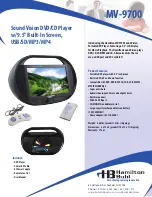
7.4.2 - Drying method
a) Drying the rotor
The proper method for drying the windings of an alterna-
tor is to use a low-voltage current (that can be obtained
with an alternating current or direct current welding outfit)
in such a way that the current does not exceed 3/4 of the
rated current. Several thermometers must be positioned
at different places on the winding and checked frequently
so that the temperature does not exceed 75
°
C. If one of
the thermometers exceeds this value, immediately re-
duce the value of the current by at least 10%. The alter-
nator can also be dried by an external heat source, for
example, heaters or lamps, whilst nonetheless leaving
an opening as a damp air exhaust.
b) Drying the stator
The winding resistance is too low for the use of an out-
side electric heat source such as a welding outfit. Install
heaters or heating lamps at each end of the alternator in
order to obtain an adequate source of heat. Do not posi-
tion the heating system too near the windings in order to
avoid their over-heating.
c) Drying procedure
While the machine is drying, measurements must be tak-
en with a megohmmeter at the start, then repeated every
hour. To check the progress, plot the reading on the X-
axis and the time on the Y-axis. Increase the intensity of
the heating system steadily for a period of 2 to 4 hours in
order to obtain an adequate value until the temperature
stabilizes. When the resistance is constant, it may be as-
sumed that the alternator is dry. Depending on the size
of the machine and on the degree of dampness, this ope-
ration may take from 4 to 72 hours.
CAUTION :
TAKE FIRE-PREVENTION MEASURES DURING THE
DRYING OF THE MACHINE. ALL THE CONNEC-
TIONS MUST BE TIGHTENED.
8 - RECOMMENDED SPARE PARTS
For any further information or spare parts order
please note the number of the machine located
on the nameplate.
7.4.2 - Méthode de séchage
a) Séchage du rotor
La bonne méthode pour sécher
les bobinages d'un alternateur est d'alimenter par un
courant de faible tension que l'on peut obtenir avec un
poste à soudure courant alternatif ou courant continu de
façon à ce que le courant n'excède pas les 3/4 du cou-
rant nominal. Placer plusieurs thermomètres dans diffé-
rents endroits du bobinage et les vérifier souvent pour
que la température n'excède pas 75
°
C. Si l'un des ther-
momètres dépasse cette valeur, réduire immédiatement
la valeur du courant d'au moins 10%.L'alternateur peut
aussi être séché par une source de chaleur externe qui
proviendrait de résistance ou des lampes en laissant
toutefois une ouverture pour la sortie de l'air humide.
b) Séchage du stator La résistance du bobinage est
trop basse pour utiliser une source électrique de chaleur
extérieure comme par exemple un poste de soudure. In-
staller des résistances de réchauffage ou des lampes
chauffantes à chaque extrémité de l'alternateur afin d'ob-
tenir une source de chaleur suffisante. Ne pas position-
ner le système de chauffage trop près des bobinages afin
d'éviter leur surchauffe.
c) Procédure de séchage
Lors du séchage de la machine, on doit effectuer des
lectures avec un Megger au départ puis à fréquence ré-
pétées d'une heure. Pour vérifier l' avancement, placer la
lecture en abcisse et le temps en ordonnée. Augmenter
l'intensité du système de chauffe progressivement pen-
dant une période de 2 à 4 heures pour obtenir une va-
leur suffisante jusqu'à ce que la température se stabilise.
Quand la résistance devient constante, on suppose que
l'alternateur est sec. Cette opération peut demande, en
fonction de la taille de la machine et du degré d'humidité,
entre 4 et 72 heures.
ATTENTION :
PRENDRE LES PRECAUTIONS CON-TRE LE FEU
LORS DU SECHAGE DE LA MACHINE. TOUTES LES
CONNECTIONS DOIVENT ETRE SERREES.
8 - PIECES DE RECHANGES CONSEILLEES
Pour toute demande de renseignements ou
commande de pièces de rechange veuillez pré-
ciser le N
°
de la machine inscrit sur la plaque
signalétique.
Description
Quantité
LSA 50
LSA 51
Quantity
Description
Roulement côté accouplement
1
6226 C3
6232 MC3
1
Bearing on coupling side
Roulement côté opposé à
l'accouplement
1
6226 C3
NU 1028 MC3
1
Bearing on side opposite the
coupling
Diodes
6
SKR 130/12
SKR 130/12
6
Diodes
Regulateur
AREP -
Shunt -
Compound -
1
Type R 449
Type R 200
Type R130
Type R 449
Type R 200
Type R130
1
A.V.R
- AREP
- Shunt
- Compound
23
Alternators
LSA 50-51
Alternateurs
LSA 50-51





































